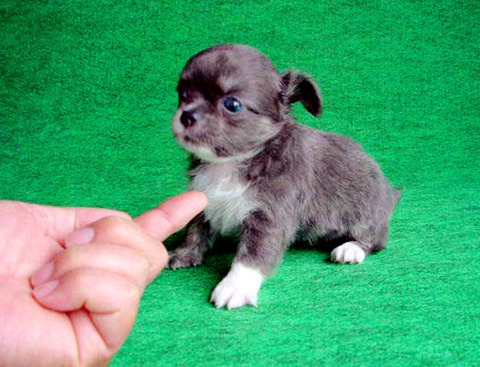Care for a Chihuahua with a blue hue? How about a teacup poodle so tiny it will fit into a purse — the canine equivalent of a bonsai? The Japanese sure do.
Rare and unique dogs are highly prized here and can set buyers back more than US$10,000. But the problem is what often arrives in the same litter: genetically defective sister and brother puppies born with missing paws or faces lacking eyes and a nose.
There have been dogs with brain disorders so severe that they spent all day running in circles, and others with bones so frail they dissolved in their bodies. Many carry hidden diseases that crop up years later, veterinarians and breeders say.

Kiyomi Miyauchi was heartbroken to discover this after one of two Boston terriers she bought years ago suddenly collapsed last year into spasms on the living room floor and died. In March, one of its puppies died the same way; another went blind.
Miyauchi stumbled across a widespread problem here that is only starting to get attention. Rampant inbreeding has given Japanese dogs some of the highest rates of genetic defects in the world, sometimes four times higher than in the US and Europe.
These illnesses are the tragic consequences of the national penchant in Japan for turning things cute and cuddly into social status symbols. But they also reflect the fondness for piling onto fads in Japan, a nation that always seems caught in the grip of some trend or other.
"Japanese are maniacs for booms," said Toshiaki Kageyama, a professor of veterinary medicine specializing in genetic defects at Azabu University in Sagamihara. "But people forget here that dogs aren't just status symbols. They are living things."
Dogs are just one current rage. Less consequential is the big boom in the color pink: pink digital cameras, pink portable game consoles and, yes, pink laptop computers have become must haves for young women. Last year, it was "bug king," a computer game with battling beetles.
A number of the booms in Japan, including Tamogotchi, basically a virtual chicken that hatched and grew on a computer screen, and the fanciful cartoon characters of Pokemon, have made their way across the Pacific and swept up American children, too.
The affection for fads in Japan reflects its group-oriented culture, a product of the conformity taught in its grueling education system. But booms also take off because they are fueled by big business. Companies like Sony and Nintendo are constantly looking to create the next adorable hit, churning out cute new characters and devices. Booms help sustain an entire industrial complex, from software makers to marketers and distributors, that thrives off the pack mentality of consumers in Japan.
The same thing is happening in Japan's fast-growing pet industry, estimated at more than US$10 billion a year. Chihuahuas are the current hot breed, after one starred in the television ads of a finance company. In the early 1990s, a TV drama featuring a Siberian husky helped send annual sales rocketing from just a few hundred dogs to 60,000 and then back down again when the fad cooled, according to the Japan Kennel Club. The breed took off despite being too large for most cramped homes in Japan.
The US also experiences surges in sales of certain breeds, and some states have confronted "puppy mills" that churn out popular breeds by enacting "puppy lemon laws" to keep breeders from selling diseased animals.
But in Japan, the sales spikes are far more extreme. The kennel club says unethical breeders try to cash in on the booms, churning out puppies from a small number of parents. While many breeders have stuck to healthy mating practices, the lure of profits has attracted less scrupulous breeders and the proliferation of puppy mills.
Some veterinarians and other experts cite another, less obvious factor behind widespread risky inbreeding in Japan's dog industry — the nation's declining birth rate.
As the number of childless women and couples in Japan has increased, so has the number of dogs, which are being coddled and doted upon in place of kids, experts say. In the last decade, the number of pet dogs in Japan has doubled to 13 million last year — outnumbering children under 12 — according to Takashi Harada, president of Yaseisha, a publisher of pet magazines.
"Households with few or no children are turning to dogs to fill the void," he said. "For a dog to be part of the family, it has to be unique and have character, like a person."
Indeed, many of these buyers want dogs they can show off like proud parents. They are willing to pay top yen, with rarer dogs fetching higher prices. Coveted traits like a blue-tinged coat are often the result of recessive genes, which can determine appearance only when combined with another recessive gene.
Inbreeding is a quick way to bring out recessive traits, as dogs carrying the gene are repeatedly mated with their own offspring, enhancing the trait over successive generations.
When done carefully, some types of inbreeding are safe. But in Japan, too many breeders throw aside caution in search of a quick profit, experts say. In these cases, for every dog born with prized colors, many more appear with defects, also the product of recessive genes.
"The demand is intense, and so is the temptation," said Eiichi Kawanabe, one of the country's top Chihuahua breeders. "There are a lot of bad breeders out there who see dogs as nothing more than an industrial product to make quick money."

In the next few months tough decisions will need to be made by the Taiwan People’s Party (TPP) and their pan-blue allies in the Chinese Nationalist Party (KMT). It will reveal just how real their alliance is with actual power at stake. Party founder Ko Wen-je (柯文哲) faced these tough questions, which we explored in part one of this series, “Ko Wen-je, the KMT’s prickly ally,” (Aug. 16, page 12). Ko was open to cooperation, but on his terms. He openly fretted about being “swallowed up” by the KMT, and was keenly aware of the experience of the People’s First Party

Aug. 25 to Aug. 31 Although Mr. Lin (林) had been married to his Japanese wife for a decade, their union was never legally recognized — and even their daughter was officially deemed illegitimate. During the first half of Japanese rule in Taiwan, only marriages between Japanese men and Taiwanese women were valid, unless the Taiwanese husband formally joined a Japanese household. In 1920, Lin took his frustrations directly to the Ministry of Home Affairs: “Since Japan took possession of Taiwan, we have obeyed the government’s directives and committed ourselves to breaking old Qing-era customs. Yet ... our marriages remain unrecognized,

Not long into Mistress Dispeller, a quietly jaw-dropping new documentary from director Elizabeth Lo, the film’s eponymous character lays out her thesis for ridding marriages of troublesome extra lovers. “When someone becomes a mistress,” she says, “it’s because they feel they don’t deserve complete love. She’s the one who needs our help the most.” Wang Zhenxi, a mistress dispeller based in north-central China’s Henan province, is one of a growing number of self-styled professionals who earn a living by intervening in people’s marriages — to “dispel” them of intruders. “I was looking for a love story set in China,” says Lo,

Standing on top of a small mountain, Kim Seung-ho gazes out over an expanse of paddy fields glowing in their autumn gold, the ripening grains swaying gently in the wind. In the distance, North Korea stretches beyond the horizon. “It’s so peaceful,” says the director of the DMZ Ecology Research Institute. “Over there, it used to be an artillery range, but since they stopped firing, the nature has become so beautiful.” The land before him is the demilitarized zone, or DMZ, a strip of land that runs across the Korean peninsula, dividing North and South Korea roughly along the 38th parallel north. This